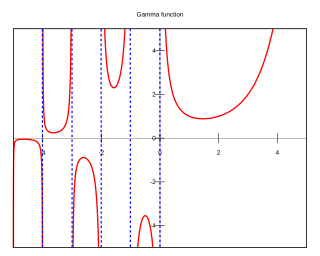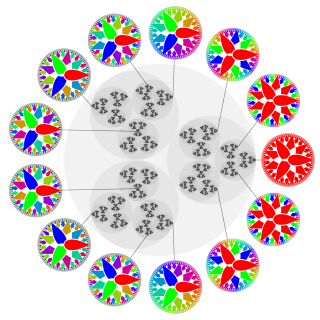
In mathematics, an abelian group, also called a commutative group, is a group in which the result of applying the group operation to two group elements does not depend on the order in which they are written. That is, the group operation is commutative. With addition as an operation, the integers and the real numbers form abelian groups, and the concept of an abelian group may be viewed as a generalization of these examples. Abelian groups are named after early 19th century mathematician Niels Henrik Abel.

In mathematics, the binomial coefficients are the positive integers that occur as coefficients in the binomial theorem. Commonly, a binomial coefficient is indexed by a pair of integers n ≥ k ≥ 0 and is written It is the coefficient of the xk term in the polynomial expansion of the binomial power (1 + x)n; this coefficient can be computed by the multiplicative formula
In number theory, two integers a and b are coprime, relatively prime or mutually prime if the only positive integer that is a divisor of both of them is 1. Consequently, any prime number that divides a does not divide b, and vice versa. This is equivalent to their greatest common divisor (GCD) being 1. One says also ais prime tob or ais coprime withb.
In mathematics, the factorial of a non-negative integer , denoted by , is the product of all positive integers less than or equal to . The factorial of also equals the product of with the next smaller factorial:

In mathematics, the gamma function is one commonly used extension of the factorial function to complex numbers. The gamma function is defined for all complex numbers except the non-positive integers. For every positive integer n,

In mathematics, specifically abstract algebra, an integral domain is a nonzero commutative ring in which the product of any two nonzero elements is nonzero. Integral domains are generalizations of the ring of integers and provide a natural setting for studying divisibility. In an integral domain, every nonzero element a has the cancellation property, that is, if a ≠ 0, an equality ab = ac implies b = c.
In mathematics, a principal ideal domain, or PID, is an integral domain in which every ideal is principal, i.e., can be generated by a single element. More generally, a principal ideal ring is a nonzero commutative ring whose ideals are principal, although some authors refer to PIDs as principal rings. The distinction is that a principal ideal ring may have zero divisors whereas a principal ideal domain cannot.

In mathematics, a sequence is an enumerated collection of objects in which repetitions are allowed and order matters. Like a set, it contains members. The number of elements is called the length of the sequence. Unlike a set, the same elements can appear multiple times at different positions in a sequence, and unlike a set, the order does matter. Formally, a sequence can be defined as a function from natural numbers to the elements at each position. The notion of a sequence can be generalized to an indexed family, defined as a function from an arbitrary index set.

In mathematics, rings are algebraic structures that generalize fields: multiplication need not be commutative and multiplicative inverses need not exist. In other words, a ring is a set equipped with two binary operations satisfying properties analogous to those of addition and multiplication of integers. Ring elements may be numbers such as integers or complex numbers, but they may also be non-numerical objects such as polynomials, square matrices, functions, and power series.

In number theory, a Gaussian integer is a complex number whose real and imaginary parts are both integers. The Gaussian integers, with ordinary addition and multiplication of complex numbers, form an integral domain, usually written as or

In mathematics, the p-adic number system for any prime number p extends the ordinary arithmetic of the rational numbers in a different way from the extension of the rational number system to the real and complex number systems. The extension is achieved by an alternative interpretation of the concept of "closeness" or absolute value. In particular, two p-adic numbers are considered to be close when their difference is divisible by a high power of p: the higher the power, the closer they are. This property enables p-adic numbers to encode congruence information in a way that turns out to have powerful applications in number theory – including, for example, in the famous proof of Fermat's Last Theorem by Andrew Wiles.
In mathematics, a unique factorization domain (UFD) is a ring in which a statement analogous to the fundamental theorem of arithmetic holds. Specifically, a UFD is an integral domain in which every non-zero non-unit element can be written as a product of prime elements, uniquely up to order and units.
This article collects together a variety of proofs of Fermat's little theorem, which states that
In algebra and number theory, Wilson's theorem states that a natural number n > 1 is a prime number if and only if the product of all the positive integers less than n is one less than a multiple of n. That is, the factorial satisfies
In mathematics, a free abelian group is an abelian group with a basis. Being an abelian group means that it is a set with an addition operation that is associative, commutative, and invertible. A basis, also called an integral basis, is a subset such that every element of the group can be uniquely expressed as an integer combination of finitely many basis elements. For instance the two-dimensional integer lattice forms a free abelian group, with coordinatewise addition as its operation, and with the two points (1,0) and (0,1) as its basis. Free abelian groups have properties which make them similar to vector spaces, and may equivalently be called free-modules, the free modules over the integers. Lattice theory studies free abelian subgroups of real vector spaces. In algebraic topology, free abelian groups are used to define chain groups, and in algebraic geometry they are used to define divisors.
In mathematics, specifically order theory, a well-quasi-ordering or wqo on a set is a quasi-ordering of for which every infinite sequence of elements from contains an increasing pair with

In modular arithmetic, the integers coprime to n from the set of n non-negative integers form a group under multiplication modulo n, called the multiplicative group of integers modulo n. Equivalently, the elements of this group can be thought of as the congruence classes, also known as residues modulo n, that are coprime to n. Hence another name is the group of primitive residue classes modulo n. In the theory of rings, a branch of abstract algebra, it is described as the group of units of the ring of integers modulo n. Here units refers to elements with a multiplicative inverse, which, in this ring, are exactly those coprime to n.
In mathematics, a Witt vector is an infinite sequence of elements of a commutative ring. Ernst Witt showed how to put a ring structure on the set of Witt vectors, in such a way that the ring of Witt vectors over the finite field of order is isomorphic to , the ring of -adic integers. They have a highly non-intuitive structure upon first glance because their additive and multiplicative structure depends on an infinite set of recursive formulas which do not behave like addition and multiplication formulas for standard p-adic integers.

In mathematics, an algebraic number field is an extension field of the field of rational numbers such that the field extension has finite degree . Thus is a field that contains and has finite dimension when considered as a vector space over .
In mathematics, a profinite integer is an element of the ring










